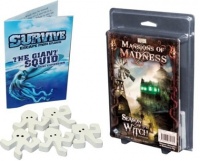
Get In The Game is a weekly column by Dan Yarrington, managing partner of Myriad Games in Manchester & Salem, New Hampshire, Treasurer of the Professional Game Store Association, and Editor-in-Chief of GameSalute.com. This week, asks for more intro-type mini-games as a way to expand the market.
Welcome back to Get In The Game, a column that explores proactive ways we can improve the games industry. This week, we look at an important lesson tabletop game companies can learn from digital games.
What’s In A Mini-Game
I’m not talking about miniatures games here. I’m talking about mini-games of the kind that you’ll find in digital games. These are the little things that aren’t quite a full game themselves. I’m also talking about very small, low-price-point expansions to existing games. And I’m also talking about the experience of trying out a part of a game without jumping into the whole thing. Mini-games should be affordable (preferably $10 or less), should be short (less than 30 minutes), and can be new content or just a part of the full content of a game. They can happen within a game or as a precursor or preview to a game. They’re also called demos (just the first level for instance). It’s a bit of a game that can give the consumer a taste of what the game is before purchasing. We need more of these in the tabletop games market.
It Can’t Be Done!
Poppycock! It’s already being done. Steve Jackson has done Munchkin demo sets (e.g. Munchkin Rigged which became Munchkin Reloaded). Fantasy Flight Games is doing small print on demand expansions for games like Death Angel and Mansions of Madness. Mayfair Games has demo scripts to go with game library copies of the games, so that you can show off a turn or two without investing in the entire length of the game. The Dresden Files offered PDF previews of the game. Small World has had 4 mini-game expansions in addition to the base game and the new standalone Underground version. And that’s not to mention the ever increasing digital incarnations of these games on iOS, Android, and web-based platforms. Carcassonne, Settlers of Catan, Roll Through the Ages, Ticket to Ride, Kingsburg, and many, many, many more have electronic versions available. These do not replace the experience of face-to-face games, but enhance it--bringing those brands into broader availability, adding solitaire play against AI, and making the games portable.
Why Not Just Make Real Games
Silly rabbit! Mini-games are games. They’re an integral part of the video game industry, especially with most titles releasing priced between $50 and $60. They’re more accessible than full versions of a game and are as important as reviews and previews to properly selling a game. The other incarnation of this model in video games is DLC (Downloadable Content), which are generally inexpensive small expansions for an existing game. We have the capability to make this happen on tabletops as well, through specially released demo products, game library copies in local stores for gamers to check out in person, and digital versions released as the game launches to introduce the mechanics and theme to the customer. From a publisher’s perspective, mini-games also provide additional sales options without all the heavy investment that a full game requires. You can design, develop, and produce an entire line for about the same effort you’d produce a single title. You can release your big box game and mini-game introductory version at the same time (not later to juice the sales of an already existing line--it needs to be out at the same time as the main release, or preferably in advance). You can steadily release mini-expansions over the course of the next year to maintain awareness for the line. You’re enhancing the game by releasing mini-games.
Make New Customers, But Keep The Old...
Lower price points of mini-games mean folks are more likely to try out games. If I’m a new customer to the realm of designer games, and I think that board games are only for kids and should be no more than $20, I’m going to balk at paying $50-60 for your game, no matter how awesome it is. For only $5-10, I’m more likely to try a game. And if I like the mini-game, I might pick up the full game too. It makes games less intimidating. Ideally these mini-game introductions would have a solitaire version, since they’re designed for folks to learn. I could even see potential for a sampler pack that would come out each month with mini-games for the major releases, encouraging folks to try them all. And for the existing gamers, these can provide expansions where they would not be affordable or feasible before. You’re not tied to the formatting and printing requirements of full box games. You can right-size an expansion or spread expansion contents out over a few releases to make them more palatable and more exciting. This is the “living” model shown in Fantasy Flight’s Living Card Games. Steady, affordable releases. But it’s not limited to those types of games. Every game should have a mini-game version. Mini-games will yield greater accessibility and better support.
Am I right? Am I wrong? Am I an insidious miscreant not worthy of uttering the name of your most precious game title? Would you sell more games if you used the mini-games format? Tell me now by Talking Back!
What are you waiting for? Get In The Game!


